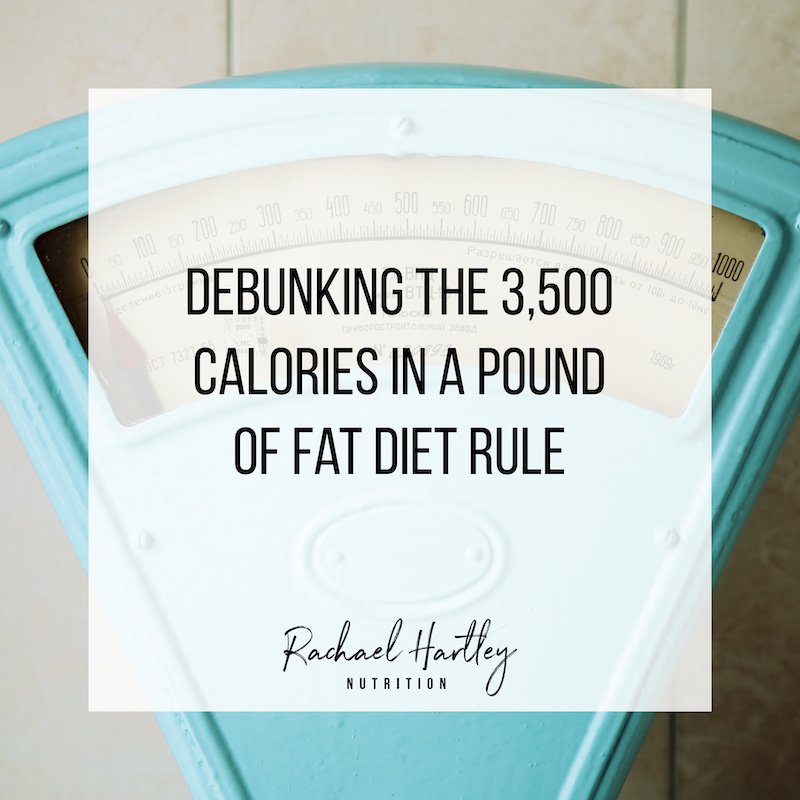[ad_1]

CW: Discussion of calories, weight and numbers, which perhaps could be gleaned from the title of the article, but just in case 😉
We’ve all heard the “simple” rule to lose a pound a week. A pound of fat supposedly stores 3,500 calories, so if you want to lose a pound a week, just eat 500 calories less a day, exercise them off, or do a little of both. It’s as simple as that!
Except it’s not.
I’m embarrassed to say that early on in my dietetics career, before I practiced from a non-diet lens, this was a piece of advice I gave out on the regular. The 3,500 calorie rule was simple and easy to understand – perfect for those quick diet educations all us RDs have to do when we work inpatient clinical jobs.
It’s pretty horrifying to me now all the misinformation I was taught while in school to become a dietitian, and I went through some pretty solid nutrition programs! As is the case with the 3500 calories in a pound of fat rule, sometimes misinformation is taught because it is simple and consumer friendly, and because they don’t see a downside to it. Because cutting calories when someone wants to lose weight is always healthy, right? If we can teach people an easy way to do that, no harm, no foul.
Except that it does cause harm. Quite a bit actually.
Spreading a falsehood that makes weight loss out to be some simple mathematical equation fuels the diet cycle and yo-yo dieting. When people don’t lose the magical pound a week, they feel like a failure, setting off a cascade of more and more restrictive diets, or a shame and hopelessness fueled eating backlash. It also makes people cut out a pretty significant, and sometimes even dangerous amount of calories, because while yes, there are people out there who could reduce their average caloric intake by 500 calories daily and still be eating an appropriate amount of food, there’s A LOT of people for whom that kind of reduction could put them into eating disorder territory.
The 3,500 calorie rule also does something I talk a lot about with my clients, where it takes a kernel of truth but waters it down or sensationalizes it so it’s no longer helpful or accurate. Diet culture just loves spreading these overly simplified rules!
While the 3500 calories in a pound of fat rule is simple, the reality of human biology is much more complex, and I’d argue much more interesting!
Where does the 3,500 calories in a pound of fat myth come from?
Back in 1958, a doctor and researcher named Max Wishnofsky published a report titled “What is the caloric equivalent of one pound of body weight gained or lost.” In it, he concluded that 1 lb of fat contained approximately 3,500 calories. Since then, his report has been cited thousands of times in some of the most influential medical journals.
It’s a little bit difficult to know exactly what his methods were, as only the first page is available for free online, but it appears he essentially converted the weight of a pound of adipose tissue (aka fat) to grams, corrected for the amount of that adipose tissue that is fluid, proteins, and other non-fat substance. Since we know that 1 gram of animal fat contains about 9 calories, it’s an easy multiplication to arrive at 3,500 calories in a pound a fat.
While a pound of adipose tissue does contain in the range of 3,500 calories, the problem with this fact is how diet culture applies it. By overly simplifying human biology, it creates a rule that promises everyone if you can just do the “right” thing and cut 500 calories a day, you can essentially pick what weight you wan to be.
[ad_2]
Source link




More Stories
Your Life Can Be Part of A Beautiful Painting by Following a Healthy Lifestyle
Children’s Dental Care and Early Prevention
Top Ten Attitudes of Health and Fitness